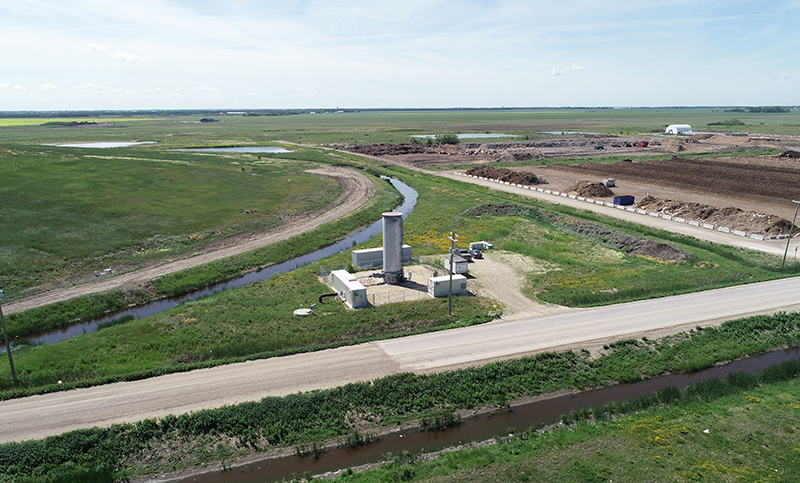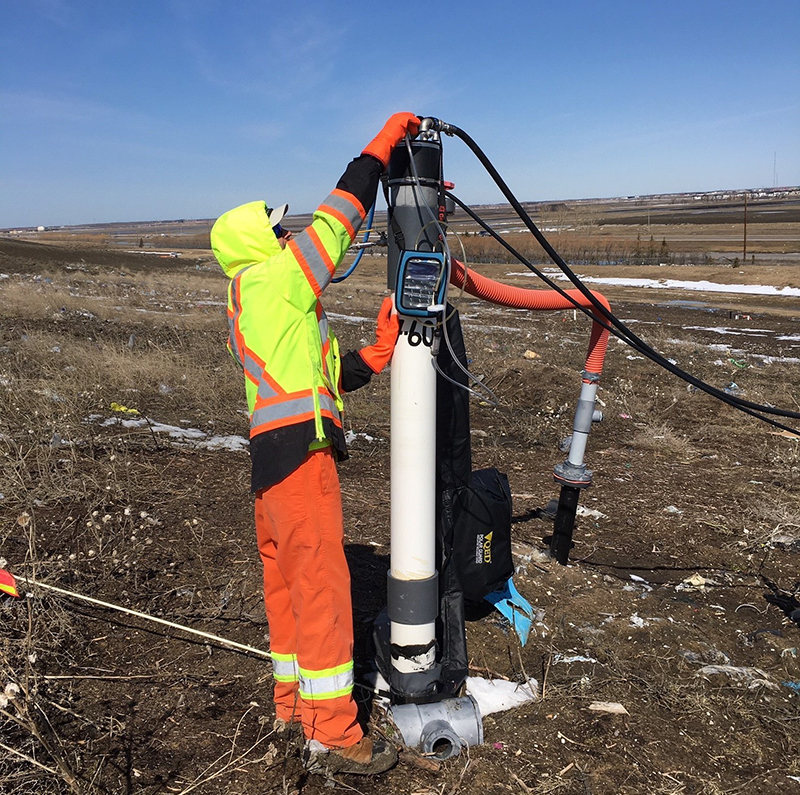
Summary
Like all landfills, Winnipeg’s Brady Road Resource Management Facility produces methane-rich landfill gas, which contributes to the city’s greenhouse gas emissions and carbon footprint. A collect and flare system was installed beginning in 2012 to reduce emissions, but the city wanted to explore the opportunity to benefit from the landfill gas by turning it into a source of revenue. This study assesses four scenarios for capturing, processing and selling landfill gas, and concludes that the preferred option is to convert the landfill gas into renewable natural gas to sell on the open market.
Background
The Brady Road Resource Management Facility, then called the Brady Road Landfill, opened in 1973 to receive solid waste from Winnipeg and the surrounding region. Located to the south of the city, it accepts both residential and commercial waste—a total of 315,500 tonnes in 2021. In 2011, Winnipeg’s waste disposal was responsible for close to 800,000 tonnes of carbon dioxide equivalent (tCO2e) in emissions, almost 15 percent of the city’s total.
Since 2013 the facility has shifted its focus from primarily garbage disposal to a more circular approach to waste management. For instance, leaf and yard waste from curbside collection is now processed on a nine-hectare composting pad into nutrient-rich compost, and a wood recycling program diverts ash trees and old lumber from the landfill, using it instead to create products like furniture and flooring.
In 2012, a system was installed to collect and flare landfill gas (LFG). Landfills produce this gas—primarily made up of methane, a potent greenhouse gas (GHG)—as organic waste decomposes. Collecting and burning LFG results in lower overall GHG emissions and provides other benefits such as reduced odours. The landfill’s system of gas extraction wells was expanded in 2017 and 2020 and currently includes 80 wells covering about 55 hectares of waste (65 percent of the total waste area). The city expects to further expand this LFG collection system over time, resulting in an increase in the amount of gas collected.

The challenge
While collecting and flaring LFG does reduce GHG emissions, it does not eliminate them. One possibility for further reducing emissions is to use the LFG collected as a source of energy. This fuel can offset demand for energy from other sources while also providing a source of revenue for the waste management facility and the community. The challenge the City faced was determining the best way to use this gas, both from a fiscal perspective and in terms of environmental and social benefits.
Approach
The City of Winnipeg commissioned a study to explore four different scenarios:
- Generating electricity in an on-site facility, then selling it to Manitoba Hydro.
- Processing the LFG into pipeline-quality renewable natural gas (RNG), then selling it on the open market.
- Processing the LFG into a low-grade fuel and supplying it to the University of Manitoba.
- Selling raw LFG to an independent power producer.
Each of these scenarios was assessed for potential costs and benefits over a 20-year period, as well as for additional environmental, social and economic factors such as reducing Winnipeg’s carbon footprint.
One issue under consideration, for example, was the expected output of LFG from the facility. The team assessed various factors such as organics diversion rates and capture efficiency to come up with a realistic forecast to base revenue estimates on. The maturity of each technology was a consideration as well, as was the presence of existing test cases elsewhere in North America. The analysis also evaluated scenarios for contractual risks and regulatory requirements.

Barriers
One difficulty in conducting this study was obtaining accurate revenue figures from potential markets. Representatives of these markets were often reluctant to provide these numbers. Therefore, conservative figures were used with contingency added where necessary.
Results
Following the analysis, two scenarios—selling RNG on the open market and selling raw LFG to an independent power producer—were found to have the potential of generating revenue for the city, with a net present value of $21.36 million and $4.26 million respectively. Since the estimated revenue from the RNG option is significantly higher, study authors recommended that the city proceed with a business case and further estimate to build and operate a facility that will process and sell pipeline-quality gas.
Benefits
The completion of this study opens the door for Winnipeg to proceed toward making use of the LFG that is currently collected and flared at the Brady Road Resource Management Facility. Not only will this have the benefit of generating revenue, but it will help Winnipeg reach the GHG targets outlined in its Climate Action Plan, as the RNG produced can offset energy produced by natural gas and other fossil fuels.
Lessons learned
One key lesson from this project is the importance of keeping all stakeholders informed and engaged throughout the study. Even if public consultation is not required, including it in the process can help reduce project delays down the road, for instance due to citizens wishing to discuss concerns with the city.
Next steps
In March 2022, council agreed to move forward in negotiations to become a supplier of raw resource LFG to a third party, which will convert the gas to RNG and then sell it on the market. This option was chosen as it presents lower risk and liability as well as a more diverse client base. In addition, associated revenues are to go into a new reserve fund for climate change initiatives.
Want to explore all GMF-funded projects? Check out the Projects Database for a complete overview of funded projects and get inspired by municipalities of all sizes, across Canada.

